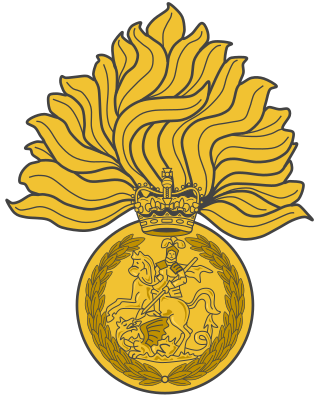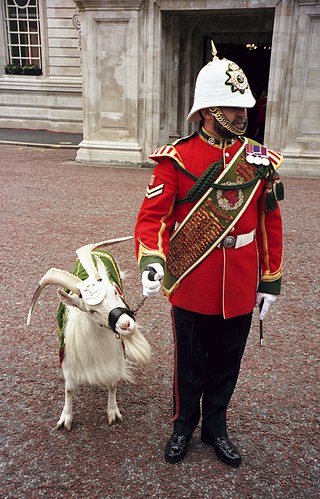The Infantry of the British Army comprises 49 infantry battalions, from 19 regiments. Of these, 33 battalions are part of the Regular army and the remaining 16 a part of the Army Reserve. The British Army's Infantry takes on a variety of roles, including armoured, mechanised, air assault and light.

The Royal Regiment of Fusiliers is an infantry regiment of the British Army, part of the Queen's Division. Currently, the regiment has two battalions: the 1st Battalion, part of the Regular Army, is an armoured infantry battalion based in Tidworth, Wiltshire, and the 5th Battalion, part of the Army Reserve, recruits in the traditional fusilier recruiting areas across England. The Royal Regiment of Fusiliers was largely unaffected by the infantry reforms that were announced in December 2004, but under the Army 2020 reduction in the size of the Army, the 2nd Battalion was merged into the first in 2014.
Options for Change was a restructuring of the British Armed Forces in summer 1990 after the end of the Cold War.

The Royal Canadian Regiment (RCR) is an infantry regiment of the Canadian Army. The regiment consists of four battalions, three in the Regular Force and one in the primary reserve. The RCR is ranked first in the order of precedence amongst Canadian Army infantry regiments, but in a quirk of the rules of seniority, its 4th battalion is ninth.

The Royal Gloucestershire, Berkshire and Wiltshire Regiment was a short-lived infantry regiment of the British Army.

The Princess of Wales's Royal Regiment (PWRR), also known as the Tigers, is the senior English line infantry regiment of the British Army, second in the line infantry order of precedence to the Royal Regiment of Scotland and part of the Queen's Division.

The Royal Highland Fusiliers, 2nd Battalion, Royal Regiment of Scotland is an infantry battalion of the Royal Regiment of Scotland.

The Highlanders, 4th Battalion, Royal Regiment of Scotland is an infantry battalion of the Royal Regiment of Scotland.

The Prince of Wales's Own Regiment of Yorkshire was an infantry regiment of the British Army, part of the King's Division. It was created in 1958 by the amalgamation of the West Yorkshire Regiment and the East Yorkshire Regiment. After 48 years service, the regiment was amalgamated again, this time with two other Yorkshire regiments. It became the 1st Battalion of the Yorkshire Regiment, with the Green Howards forming the 2nd Battalion and the Duke of Wellington's Regiment forming the 3rd Battalion on 6 June 2006. Following further merges, in 2012, the battalion was redesignated as the new 2nd Battalion (2Yorks).
The Devonshire and Dorset Regiment, usually just known as the Devon and Dorsets, was an infantry regiment of the British Army formed in 1958 by the amalgamation of two county regiments, the Devonshire Regiment and the Dorset Regiment. In 2007 it was itself merged into The Rifles, a "large regiment". Members of the regiments referred to themselves as being a Janner.

The Royal Regiment of Wales was an infantry regiment of the British Army, part of the Prince of Wales' Division. It was formed in 1969 by the amalgamation of the South Wales Borderers and the Welch Regiment. The 1st Battalion, The Royal Regiment of Wales had a short existence in military terms, just over 36 years. Within two months of amalgamation, the battalion was one of the first units to be deployed to Northern Ireland.

The Worcestershire and Sherwood Foresters Regiment was an infantry regiment of the British Army, part of the Prince of Wales' Division. The regiment served as the county regiment for Derbyshire, Nottinghamshire and Worcestershire.

The Queen's Regiment (QUEENS) was an infantry regiment of the British Army formed in 1966 through the amalgamation of the four regiments of the Home Counties Brigade. Then, until 1971 the regiment remained one of the largest regiments in the army, with 10 battalions, however these were reduced to just six, and later five battalions. Following the dissolution of the Soviet Union, the Options for Change reform was published and the regiment amalgamated with the Royal Hampshire Regiment to form the Princess of Wales's Royal Regiment.
The Rifles is an infantry regiment of the British Army. Formed in 2007, it consists of four Regular battalions and three Reserve battalions. Each Regular battalion was formerly an individual battalion of one of the two large regiments of the Light Division. Since formation, the regiment has been involved in the later stages of the Iraq War and in the War in Afghanistan.

The Queen's Own Highlanders (Seaforth and Camerons), officially abbreviated "QO HLDRS," was an infantry regiment of the British Army, part of the Scottish Division. It was in existence from 1961 to 1994.
The British Army primarily divides its infantry into regiments, which are subdivided into battalions. However, for various reasons, since the end of the Second World War it has also maintained companies that are intended to provide increments and reinforcements.

The Royal Regiment of Scotland (SCOTS) is the senior and only current Scottish line infantry regiment of the British Army Infantry. It consists of three regular and two reserve battalions, plus an incremental company, each formerly an individual regiment. However, three regular battalions maintain their former regimental pipes and drums to carry on the traditions of their antecedent regiments.
The Royal Scots Borderers, 1st Battalion, the Royal Regiment of Scotland was a battalion of the Royal Regiment of Scotland. The battalion formed on 1 August 2006 when its antecedent regiments - the Royal Scots and the King's Own Scottish Borderers - amalgamated just after the formation of the Royal Regiment of Scotland in 2006.

The Wiltshire Regiment was a line infantry regiment of the British Army, formed in 1881 under the Childers Reforms by the amalgamation of the 62nd (Wiltshire) Regiment of Foot and the 99th Duke of Edinburgh's (Lanarkshire) Regiment of Foot.

Battlesbury Barracks is a British Army installation in Warminster, Wiltshire, England. It is the permanent base of the Royal Dragoon Guards, serving as armoured cavalry.













